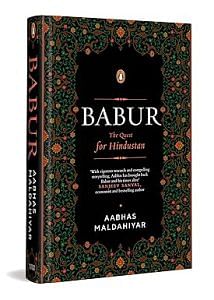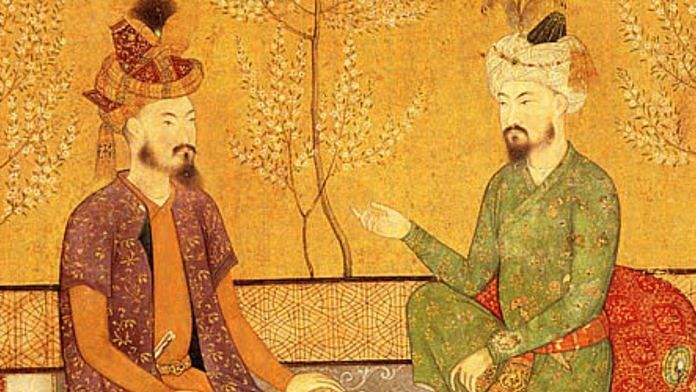With the dawn of 25 April, the true extent of their malevolence was revealed. Bābur, a spectre haunting the tombs of kings, paid homage to those who had fallen before him. The shadows of Sl. Ghiyās̤u’d-dīn Balban and Sl. ‘Alāu’u’d-dīn Khiljī loomed like giants, their whispers echoing through the corridors of time.
In the heart of Dillī, Bābur, surveyed his new dominion. Khiljī, his Minār, the Ḥauẓ-shamsī, Ḥauẓ-i-khaṣ, and the tombs and gardens of Sl. Buhlūl and Sl. Sikandar (Lūdī) lay before him. After taking stock of these symbols of power, Bābur dismounted at the camp, boarded a boat, and drank ‘araq, celebrating his ill-gotten gains.
Bābur then bestowed the Military Collectorate (shiqdārlīghī) of Dillī upon Red Walī, installed Dost Dīwān in the Dillī district, sealed the treasuries, and handed them over to his loyal minions. His actions, cloaked in the guise of administrative order, were but the machinations of a subverter consolidating his control over a conquered realm.
As the night descended once more, they stood on the banks of the Jūn, their eyes fixed upon the fortress of Tūghlūqābād, a bastion of their unyielding grip on power. With each passing day, their hold tightened like a noose around the neck of a nation gasping for freedom. And thus, the dark reign of Bābur and his cohorts continued, casting a shadow of fear and despair over the land.
The Khut̤ba Read for Bābur in Dillī
It was 27 April of AD 1526, a Friday and the fifteenth day of Rajab. While Bābur’s ominous presence loomed over the land with calculated malice, Maulānā Maḥmūd and Shaikh Zain, like silent schemers, slipped into Dillī under the guise of piety for the Congregational Prayer. They pronounced the khut̤ba in Bābur’s name, scattering illgotten gold to the Muslim subjects like poisoned seeds, and returned to the camp with sinister satisfaction.
The next day, on 28 April, departing that tainted ground, they advanced towards Āgra. Bābur, made a perfidious excursion to Tūghlūqābād before rejoining his marauding host. A week later, on 4 May of AD 1526, they dismounted at the mansion (manzil) of Sulaimān Farmulī in a suburb of Āgra. Finding the place far from the fort, they moved the following day to Jalāl Khān Jik-hat’s house, closer to their prize.
Upon Humāyūn’s arrival at Āgra ahead of the main force, the garrison, dreading Bābur’s infamous wrath, concocted excuses and false pretexts about surrender. Humāyūn, the prowling wolf, sensed the disarray and declared, ‘The long hand may be laid on the Treasury!’ positioning himself to seize the roads out of Āgra until Bābur’s arrival.
Also read: Assamese cinema was born in a tea garden. 1935 film ‘Jaimati’ was the first
The Great Diamond
In the cataclysmic defeat of Sult̤ān Ibrāhīm, the Hindū Rāja of Gwālīor, Vikramaditya, was cast into the abyss of death. Bābur, relentless and insatiable, left a trail of darkness and despair, a tempest of ruin that consumed all in its path.
Vikramāditya’s children and family languished in Āgra during the ruinous fall of Sult̤ān Ibrāhīm. As Humāyūn descended upon Āgra, their desperate plans to flee were thwarted by his strategic postings, like spiders weaving a web of entrapment. Humāyūn, embodying the will of Bābur, ensured their captivity, refusing them the mercy of escape. Under duress, they surrendered a treasure trove of jewels and valuables, among them the legendary diamond once seized by ‘Alāu’u’d-dīn. Its infamy spoke of a worth so immense that it could feed the world for two and a half days, weighing a formidable eight mis̤qāls.
When Bābur arrived in Āgra, Humāyūn, a dutiful vassal, presented this gem. Bābur, with calculated indifference, returned it to him, as if discarding a trinket. The diamond’s lustre paled in comparison to the gleam of conquest in Bābur’s eyes. In this tale of subjugation, Vikramāditya had met his doom, consigned to the infernal abyss.
Among the marked men within the fort’s sombre walls stood Malik Dād Karānī, Millī Sūrdūk and Fīrūz Khān Mīwātī, shadows of betrayal cast long by the flickering torch of justice. Convicted of treachery, the blade of fate hovered above their heads, yet the winds of intercession began to whisper. Several souls dared to plead for Malik Dād Karānī, and for days, the fortress echoed with the rhythm of petitions and denials.
In the end, mercy, that fickle mistress, graced them with a touch. Their lives were spared, their goods restored, like treasures plucked from the abyss. To Ibrāhīm’s mother, a pargana worth seven lakh Dams was bestowed—a gilded token amidst the ruins of her dynasty. Lands were scattered like chaff to the loyal begs, binding their allegiance with soil and silver. She, with her aged retainers, was exiled, her encampment set two miles below Āgra’s looming presence.
On 10 May of AD 1526, as the Afternoon Prayer went on under a dusky sky, Bābur stormed into Āgra, the conqueror’s shadow darkening the threshold. With the stride of a tempest, he dismounted at the mansion of Sult̤ān Ibrāhīm, seizing the throne with the ruthless embrace of a winter’s gale. The city bowed to his will, a conquered jewel in the grip of a relentless storm.
 This excerpt from Aabhas Maldahiyar’s ‘Babur: The Quest for Hindustan’ has been published with permission from Penguin Random House India.
This excerpt from Aabhas Maldahiyar’s ‘Babur: The Quest for Hindustan’ has been published with permission from Penguin Random House India.






